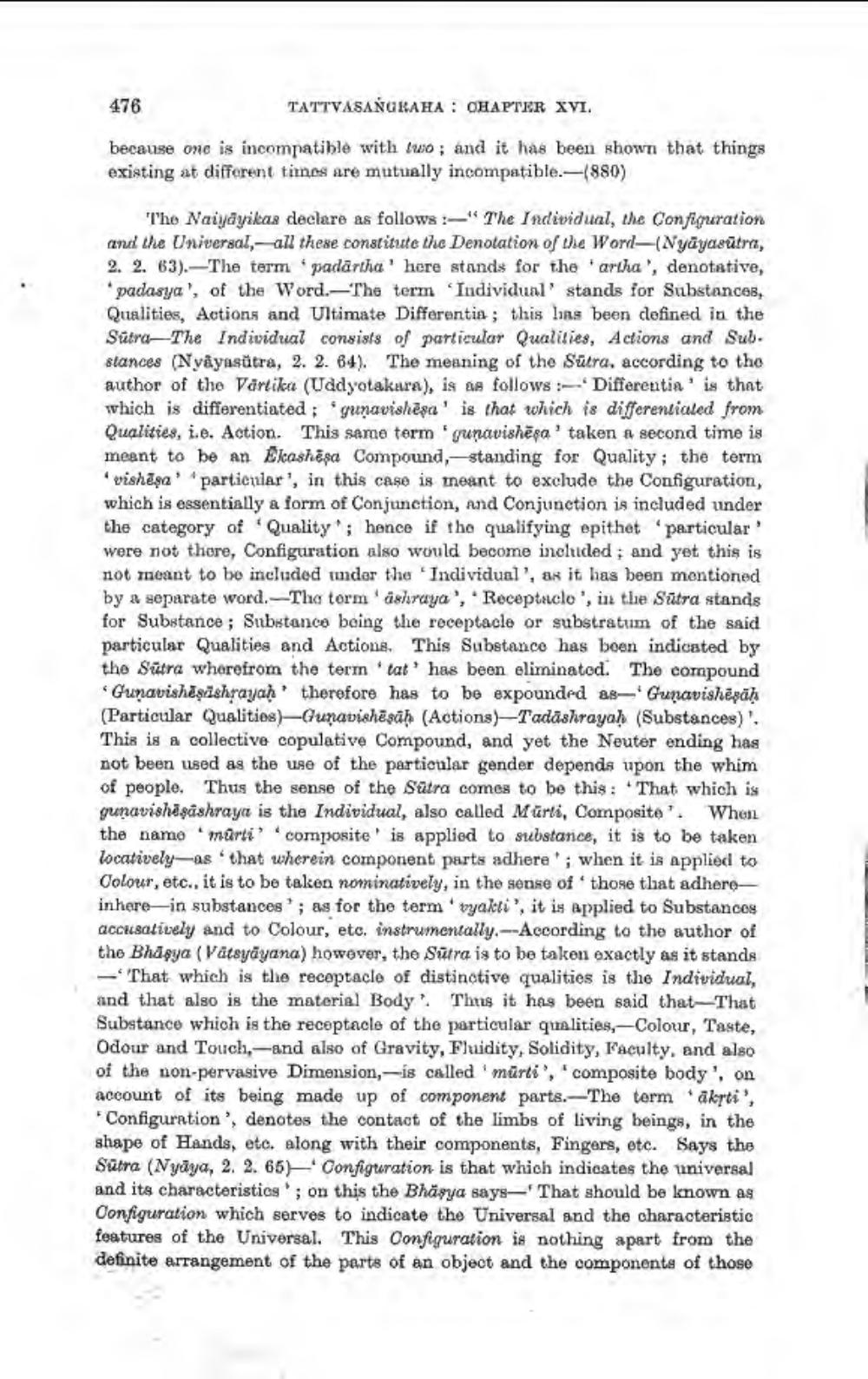________________
476
TATTVASANGRAHA : CHAPTER XVI.
because one is incompatible with two; and it has been shown that things existing at different times are mutually incompatible.—880)
"The Naiyayikas declare as follows:-" The Individual, the Configuration and the Universal,--all these constitute the Denotation of the Word-(Nyāyasūtra, 2. 2. 63).- The term padārtha' here stands for the artha', denotative,
padasya', of the Word. The term "Individual' stands for Substances, Qualities, Actions and Ultimate Differentia ; this has been defined in the Sutra-The Individual consists of particular Qualities, Actions and Sub. stances (Nyâyasätra, 2. 2. 64). The meaning of the Sutra, according to the author of the Vartika (Uddyotakura), is as follows:- Differentia' is that which is differentiated : gunavishēşa' is that which is differentialed from Qualities, i.e. Action. This same term gunavishēra ' taken a second time is meant to be an Elcashesa Compound, standing for Quality; the term 'vishēşa' particular, in this case is meant to exclude the Configuration, which is essentially a form of Conjunction, and Conjunction is included under the category of Quality; hence if the qualifying epithet particular were not thore, Configuration also would become included ; and yet this is not meant to be included imder the 'Individual', as it has been mentioned by a separate word. --The term ashraya', Receptaclo', in the Sūtra stands for Substance ; Substance being the receptacle or substratum of the said particular Qualities and Actions. This Substance has been indicated by the Sutra wherefrom the term tat' has been eliminated. The compound
Gunavishaşishrayah' therefore has to be expounded as-Gunavishēzäh (Particular Qualities)-Gunavishēsch (Actions)-Tadashrayah (Substances), This is a collective copulative Compound, and yet the Neuter ending has not been used as the use of the particular gender depends upon the whim of people. Thus the sense of the Satra comes to be this: That which is gunavishasashraya is the Individual, also called Marts, Composite'. When the name "marti' composite is applied to substance, it is to be taken locatively-as that wherein component parts adhere; when it is applied to Colour, etc., it is to be taken nominatively, in the sense of those that adhereinhere-in substances; as for the term "vyaleti', it is applied to Substances accusatively and to Colour, etc. instrumentally.---According to the author of the Bhagya (Vatsyāyana) however, the Sutra is to be taken exactly as it stands
- That which is the receptacle of distinctive qualities is the Individual, and that also is the material Body? Thus it has been said that-That Substance which is the receptacle of the particular qualities,-Colour, Taste, Odour and Touch, -and also of Gravity, Fluidity, Solidity, Faculty, and also of the non-pervasive Dimension,-is called ' mūrti', 'composite body', on account of its being made up of component parts.-The term *akrti',
Configuration', denotes the contact of the limbs of living beings, in the shape of Hands, etc. along with their components, Fingers, etc. Says the Sutra (Nyāya, 2. 2. 65) Configuration is that which indicates the universal and its characteristics'; on this the Bhāsya says-'That should be known as Configuration which serves to indicate the Universal and the characteristic features of the Universal. This Configuration is nothing apart from the definite arrangement of the parts of an object and the components of those




